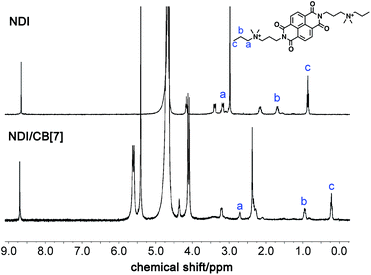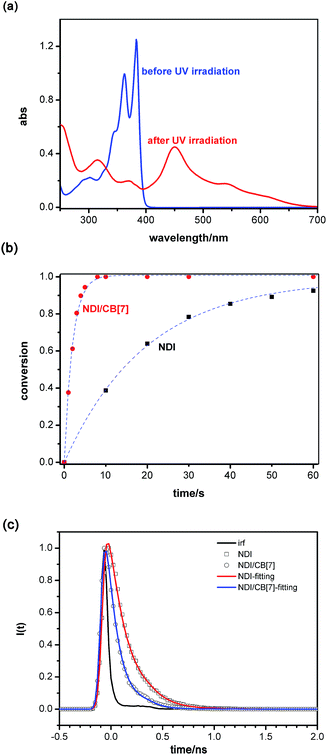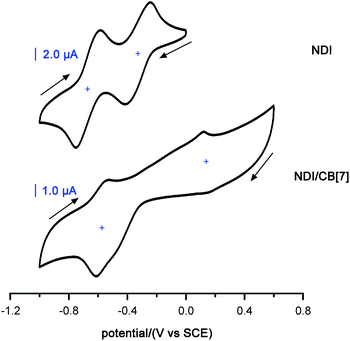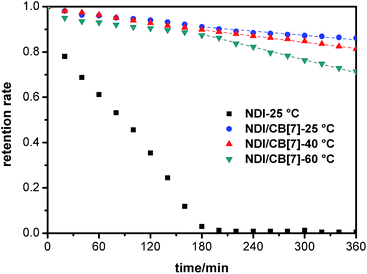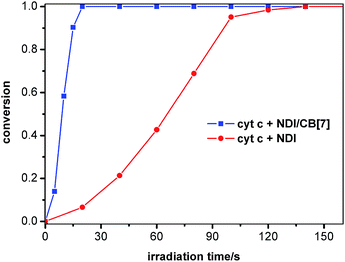 Open Access Article
Open Access ArticleA supramolecular strategy for tuning the energy level of naphthalenediimide: Promoted formation of radical anions with extraordinary stability†
Qiao
Song
,
Fei
Li
,
Zhiqiang
Wang
and
Xi
Zhang
*
The Key Lab of Organic Optoelectronics & Molecular Engineering, Department of Chemistry, Tsinghua University, Beijing 100084, P. R. China. E-mail: xi@mail.tsinghua.edu.cn
First published on 26th March 2015
Abstract
We report a supramolecular strategy to promote and stabilize the formation of naphthalenediimide (NDI) radical anions. The LUMO and HOMO energy of NDI are lowered significantly by introducing cucurbit[7]uril (CB[7]) to each side of a designed NDI molecule through supramolecular complexation. This promotes efficiently the photo-induced electron transfer process between NDI and bromide anions in aqueous solution. The resulting NDI supramolecular radical anions are of outstanding stability. They are even stable in aqueous solution at higher temperatures of 40 °C and 60 °C. It is anticipated that this supramolecular strategy may provide a facile method for stabilizing radicals towards the development of novel materials with spin-based properties and optical properties in the visible and near-infrared regions.
Introduction
Organic radicals are of prime interest because of their various spin-based applications and near-infrared optical applications.1 Most organic radicals are highly reactive due to their unpaired electrons, which are often unstable under ambient conditions; only a few families of stable radicals at ambient conditions have been reported for many decades.2 The 1,4,5,8-naphthalenediimides (NDIs) are π-electron-deficient compounds. NDI radical anions are one of the most widely studied organic radicals recently. As reported, there are two pathways to generate NDI radical anions: electron transfer (ET); or photo-induced electron transfer (PET). To display an anion-involved ET or PET process, the NDIs must possess low LUMO energy levels. Electron-withdrawing N-substituents have been introduced to NDIs to lower the LUMO energy and promote the formation of NDI radical anions.3 For example, NDI derivatives with strong electron-withdrawing phosphonium groups display a LUMO energy as low as −4.90 eV. The acquired NDI radical anions have extraordinary stability to air, light and chromatography, and can even be isolated as a single crystal.4In addition to the above covalent modification, we wondered if it is possible to realize the stabilization of radicals through noncovalent synthesis, and the complicated covalent synthesis could be avoided to some extent. Recently, there exist examples to stabilize radicals through supramolecular interactions. Kim et al. reported several cases of the stabilization of radicals in host–guest complexes.5 Methylviologen cation radicals and tetrathiafulvalene cation radicals were incorporated into the hydrophobic cavity of cucurbit[8]uril (CB[8]) in a molar ratio of 2![[thin space (1/6-em)]](https://www.rsc.org/images/entities/char_2009.gif) :
:![[thin space (1/6-em)]](https://www.rsc.org/images/entities/char_2009.gif) 1, forming stable radical dimers, respectively. The stability of the radical dimers within CB[8] may be attributed to the hydrophobic cavity with a proper size. In other words, the CB[8] is used to protect the radical dimers through a direct encapsulation strategy.
1, forming stable radical dimers, respectively. The stability of the radical dimers within CB[8] may be attributed to the hydrophobic cavity with a proper size. In other words, the CB[8] is used to protect the radical dimers through a direct encapsulation strategy.
In this paper, we aim to establish a general and facile strategy to stabilize radicals by tuning the LUMO and HOMO energy level of organic molecules through noncovalent interactions. To achieve this goal, we designed and synthesized a water-soluble NDI derivative with one quaternary ammonium alkyl chain as the N-substituent on each end, as shown in Scheme 1. Cucurbit[7]uril (CB[7]) is a macrocyclic host that contains seven electron-withdrawing carbonyl groups on each side, which was used to combine with NDI in aqueous solutions through noncovalent host–guest interactions.6 Although the NDI core was not encapsulated into the CB[7] hydrophobic cavity, the LUMO and HOMO energy of NDI would be significantly lowered because of the electron-withdrawing effect of the carbonyl groups of CB[7]. This may greatly promote the PET process between the supramolecular complex of NDI and CB[7] (NDI/CB[7]) and bromide anion to form stable NDI radical anions. It is anticipated that this strategy of fabricating supramolecular radicals could provide a facile method for stabilizing radicals towards the development of novel materials with spin-based properties and optical properties in the visible and near-infrared regions.
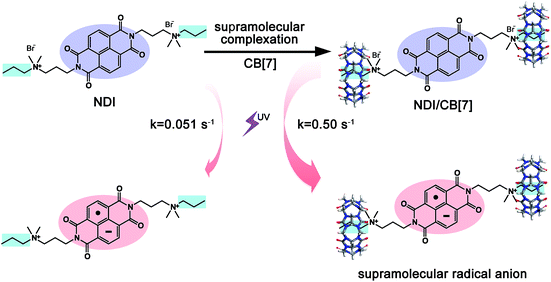 | ||
| Scheme 1 The formation of NDI radical anions is promoted and stabilized efficiently by introducing CB[7] to each side of NDI through supramolecular complexation. | ||
Results and discussion
The supramolecular complex between NDI derivative and CB[7] was prepared simply by mixing NDI and CB[7] in a molar ratio of 1![[thin space (1/6-em)]](https://www.rsc.org/images/entities/char_2009.gif) :
:![[thin space (1/6-em)]](https://www.rsc.org/images/entities/char_2009.gif) 2 in aqueous solution. As shown in the 1H NMR spectra (Fig. 1), peaks ascribed to the alkyl chains of NDI exhibited an upfield shift, indicating that CB[7] was introduced to each side of the NDI derivative. Furthermore, the ITC data indicated that complexation induced a significant change in the titration curve when CB[7] was added into the solution of NDI in a molar ratio of 2
2 in aqueous solution. As shown in the 1H NMR spectra (Fig. 1), peaks ascribed to the alkyl chains of NDI exhibited an upfield shift, indicating that CB[7] was introduced to each side of the NDI derivative. Furthermore, the ITC data indicated that complexation induced a significant change in the titration curve when CB[7] was added into the solution of NDI in a molar ratio of 2![[thin space (1/6-em)]](https://www.rsc.org/images/entities/char_2009.gif) :
:![[thin space (1/6-em)]](https://www.rsc.org/images/entities/char_2009.gif) 1. One set of binding site model was utilized to fit the isothermal titration curve, which gave a binding constant of 2.4 × 104 M−1 (see Fig. S1 in the ESI†). Therefore, noncovalent host–guest interactions between the alkyl chains in the NDI derivative and CB[7] are responsible for the formation of the NDI/CB[7] supramolecular complex with well-defined composition.
1. One set of binding site model was utilized to fit the isothermal titration curve, which gave a binding constant of 2.4 × 104 M−1 (see Fig. S1 in the ESI†). Therefore, noncovalent host–guest interactions between the alkyl chains in the NDI derivative and CB[7] are responsible for the formation of the NDI/CB[7] supramolecular complex with well-defined composition.
To understand if the supramolecular complexation could promote the PET process, we did a comparative study by irradiating the aqueous solutions of NDI/CB[7] and NDI under UV light. The NDI/CB[7] solution turned dark red after 5 s of irradiation while the NDI solution remained almost colourless in the same conditions. As monitored by UV/vis spectra (Fig. 2a), the absorption bands of NDI at 363 nm and 383 nm vanished after UV irradiation. Concomitantly, several new absorption bands at long wavelengths appeared that are characteristic of NDI radical anions.7 Moreover, the resulting NDI radical anions could be verified through electron paramagnetic resonance (EPR), which showed characteristic EPR signals after UV irradiation (see Fig. S2 in the ESI†). 1H NMR and fluorescent spectra also support the formation of NDI radical anions for the NDI/CB[7] solution (see Fig. S3 and S4 in the ESI†). We studied the reaction rates of both NDI and NDI/CB[7] by monitoring the absorption bands at 363 nm and 383 nm at different irradiation times (Fig. 2b). Simulated according to the principle of first-order reaction, the reaction rate constant of NDI/CB[7] is 0.50 ± 0.01 s−1, which is around 10 times larger than that of NDI (0.051 ± 0.001 s−1). Therefore, the formation of NDI radical anions under UV irradiation is significantly promoted because of the supramolecular complexation.
The fluorescent lifetime of both NDI and the NDI/CB[7] supramolecular complex was measured through time-resolved fluorescence measurements. As shown in Fig. 2c, the fluorescent lifetime of NDI is 165 ps, while the fluorescent lifetime of NDI/CB[7] supramolecular complex is 100 ps. The shortened fluorescent lifetime further confirms that the PET process of NDI is promoted by supramolecular complexation.
To investigate whether the LUMO and HOMO energy level of NDI was influenced by the supramolecular complexation, we evaluated the reduction potentials of NDI and the NDI/CB[7] supramolecular complex through cyclic voltammetry (CV).8 As demonstrated in Fig. 3, they both underwent two reversible one-electron reductions, forming NDI− and NDI2− species, respectively. NDI/CB[7] showed two reduction peaks at 0.138 eV and −0.557 eV while NDI showed peaks at −0.331 eV and −0.670 eV. To calculate the LUMO and HOMO energy of these two species, the UV/vis absorption spectra were utilized to estimate the HOMO–LUMO energy gap (ΔE) (Fig. 4). Both NDI and NDI/CB[7] gave identical ΔE values of 3.15 eV. From the calculated LUMO and HOMO energy shown in Fig. 4, the LUMO energy of NDI/CB[7] is 0.48 eV lower than NDI itself, and therefore the LUMO energy level is as low as −4.89 eV. This lowered LUMO energy level accounts for the promoted formation of NDI supramolecular radical anions under UV irradiation.
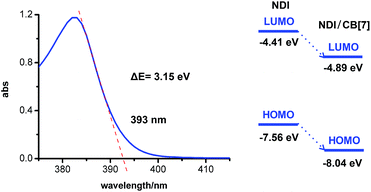 | ||
| Fig. 4 Calculation of the energy gap between the HOMO and LUMO of NDI and NDI/CB[7] (left); LUMO and HOMO energy of NDI and NDI/CB[7] (right). | ||
We wondered whether the lowered LUMO energy was due to the supramolecular complexation or simply because of physical mixing. To answer this question, a control experiment was carried out. Here, 1-adamantanamine hydrochloride (ADA), which has a much stronger binding strength with CB[7] than NDI,9 was added to the solution of the NDI/CB[7] supramolecular complex to destroy the complexation, which was verified by 1H NMR spectra (see Fig. S5 in the ESI†). The UV/vis spectra showed that the formation of NDI radical anions was greatly suppressed, which was similar to the NDI solution (see Fig. S6 in the ESI†). This control experiment reveals that the CB[7] should combine with the alkyl chains of the NDI derivative, and it is in this way that the carbonyl groups can stay close enough to affect the energy level of NDI.
The supramolecular radical anions formed in this way are of outstanding stability. The solution of NDI radical anions became colourless within a few seconds upon shaking in the ambient atmosphere, suggesting that the NDI radical anions are very unstable. However, the NDI supramolecular radical anions changed very slowly, suggesting the stability of NDI radical anions has been significantly enhanced. For more quantitative data, we studied the stability of radical anions of the NDI and NDI/CB[7] supramolecular complex in aqueous solutions via UV/vis spectroscopy. We monitored the absorption bands, which peaked at 363 nm and 383 nm at different times after UV irradiation. This gave the retention rate of the NDI radical anions as a function of time (Fig. 5). At room temperature (25 °C), the NDI supramolecular radical anions decreased only by 14% after 6 h, while the radical anions in NDI vanished completely in 3 h. Furthermore, the supramolecular radical anions are comparably stable at higher temperature with retention rates of 80% and 70% after 6 h at 40 °C and 60 °C, respectively. Therefore, not only can we promote the formation of NDI radical anions, but also we can stabilize the NDI radical anions efficiently in a supramolecular way.
The formed NDI radical anions can be utilized as a reducing agent, which allows for the function of the NDI/CB[7] supramolecular complex as supramolecular photo-reducing agent with high efficiency. Here, cytochrome c (cyt c) was selected as a model compound. Cyt c is a small redox protein in organisms, participating in the mitochondrial electron transfer chain. It contains a heme group whose central iron atom can be reversibly reduced from the Fe(III) to the Fe(II) state.10 It was reported that NDI derivatives could be used to reduce cyt c.11 The reduction kinetics of cyt c were investigated upon monitoring the absorption band peaking at 549 nm under UV irradiation at the existence of NDI or NDI/CB[7] supramolecular complex. As shown in Fig. 6, the cyt c was fully reduced in 140 s in the presence of NDI while the reduction time was shortened to only 20 s with the aid of the NDI/CB[7] supramolecular complex. Benefiting from the promoted PET of the NDI/CB[7] supramolecular complex, the reduction process of cyt c is significantly accelerated under UV irradiation, which provides a facile way to realize photo-reduction with promoted efficiency.
Importantly, this supramolecular strategy works for a wide range of NDI molecules. Taking an NDI derivative (NDI-nap) bearing one naphthalene group on each end as example (Fig. 7a), NDI-nap could combine with CB[7] in a molar ratio of 1![[thin space (1/6-em)]](https://www.rsc.org/images/entities/char_2009.gif) :
:![[thin space (1/6-em)]](https://www.rsc.org/images/entities/char_2009.gif) 2,12 which was proved by the 1H NMR spectrum and ITC (see Fig. S7 and S8 in the ESI†). There was no change in the UV/vis spectra for NDI-nap alone, but the NDI-nap/CB[7] supramolecular complex presented characteristic absorption bands of NDI radical anions after UV irradiation (Fig. 7b and c). Once again, we evaluated the LUMO and HOMO energy of the NDI-nap and NDI-nap/CB[7] based on CV and UV/vis spectra (see Fig. S9 and S10 in the ESI†). The results show that the LUMO energy of NDI-nap/CB[7] is 0.34 eV lower than NDI-nap, which proves furthermore the feasibility of this supramolecular strategy.
2,12 which was proved by the 1H NMR spectrum and ITC (see Fig. S7 and S8 in the ESI†). There was no change in the UV/vis spectra for NDI-nap alone, but the NDI-nap/CB[7] supramolecular complex presented characteristic absorption bands of NDI radical anions after UV irradiation (Fig. 7b and c). Once again, we evaluated the LUMO and HOMO energy of the NDI-nap and NDI-nap/CB[7] based on CV and UV/vis spectra (see Fig. S9 and S10 in the ESI†). The results show that the LUMO energy of NDI-nap/CB[7] is 0.34 eV lower than NDI-nap, which proves furthermore the feasibility of this supramolecular strategy.
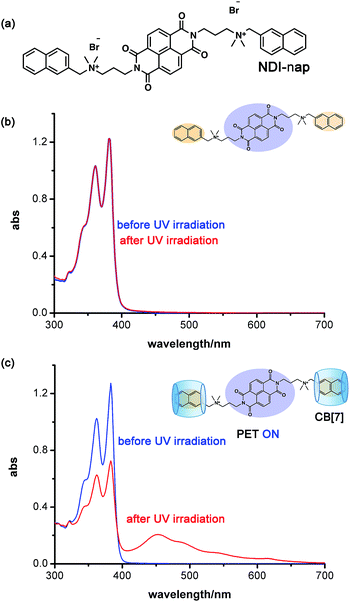 | ||
| Fig. 7 (a) Molecular structure of NDI-nap. (b) UV/vis spectra of NDI-nap before and after UV irradiation. (c) UV/vis spectra of NDI-nap/CB[7] before and after UV irradiation. | ||
Conclusions
In conclusion, we have developed a supramolecular strategy to promote and stabilize the formation of NDI radical anions through the supramolecular complexation of cucurbit[7]uril and NDI derivatives. This strategy lowers significantly the LUMO and HOMO energy of NDI, favouring the formation of NDI supramolecular radical anions with extraordinary stability. It is highly anticipated that this line of research may provide a general method to stabilize radicals through a facile supramolecular route for the development of materials with spin-based properties and optical properties in the visible and near-infrared regions.Acknowledgements
This work was financially supported by the National Basic Research Program (2013CB834502) and the Foundation for Innovative Research Groups of NSFC (211210004). We thank Mr Wei Cao and Ms Qinqin Zhou of Tsinghua University for their assistance with cyclic voltammograms. We appreciate the help of Professor Anchi Yu and Ms Huiyu Zhang from Renmin University of China with time-resolved fluorescence measurements. We thank Ms Meng Zhou of Tsinghua University for the measurement of COSY. We also thank Dr Liulin Yang and Dr Jiangfei Xu of Tsinghua University for their helpful discussions.Notes and references
- (a) R. Haddon, Nature, 1975, 256, 394 CrossRef CAS; (b) F. Würthner, Angew. Chem., Int. Ed., 2001, 40, 1037 CrossRef; (c) M. Mas-Torrent, N. Crivillers, C. Rovira and J. Veciana, Chem. Rev., 2012, 112, 2506 CrossRef CAS PubMed; (d) S. Fukuzumi, K. Ohkubo, F. D'Souza and J. Sessler, Chem. Commun., 2012, 48, 9801 RSC; (e) J. Barnes, A. Fahrenbach, D. Cao, S. Dyar, M. Frasconi, M. Giesener, D. Benitez, E. Tkatchouk, O. Chernyashevskyy, W. Shin, H. Li, S. Sampath, C. Stern, A. Sarjeant, K. Hartlieb, Z. Liu, R. Carmieli, Y. Botros, J. Choi, A. Slawin, J. Ketterson, M. Wasielewski, W. Goddard and J. Stoddart, Science, 2013, 339, 429 CrossRef CAS PubMed; (f) A. Trabolsi, N. Khashab, A. Fahrenbach, D. Friedman, M. Colvin, K. Coti, D. Benitez, E. Tkatchouk, J. Olsen, M. Belowich, R. Carmielli, H. Khatib, W. Goddard, M. Wasielewski and J. Stoddart, Nat. Chem., 2010, 2, 42 CrossRef CAS PubMed.
- (a) M. Gomberg, J. Am. Chem. Soc., 1900, 22, 757 CrossRef; (b) D. Griller and K. Ingold, Acc. Chem. Res., 1976, 9, 13 CrossRef CAS; (c) P. Power, Chem. Rev., 2003, 103, 789 CrossRef CAS PubMed; (d) C. Martin, M. Soleilhavoup and G. Bertrand, Chem. Sci., 2013, 4, 3020 RSC; (e) R. Hicks, Org. Biomol. Chem., 2007, 5, 1321 RSC; (f) O. Mallow, M. Khanfar, M. Malischewski, P. Finke, M. Hesse, E. Lork, T. Augenstein, F. Breher, J. Harmer, N. Vasilieva, A. Zibarev, A. Bogomyakov, K. Seppelt and J. Beckmann, Chem. Sci., 2015, 6, 497 RSC.
- (a) S. Nelsen, J. Am. Chem. Soc., 1967, 89, 5925 CrossRef CAS; (b) S. Guha, F. Goodson, L. Corson and S. Saha, J. Am. Chem. Soc., 2012, 134, 13679 CrossRef CAS PubMed; (c) S. Guha, F. Goodson, S. Roy, L. Corson, C. Gravenmier and S. Saha, J. Am. Chem. Soc., 2011, 133, 15256 CrossRef CAS PubMed; (d) S. Guha and S. Saha, J. Am. Chem. Soc., 2010, 132, 17674 CrossRef CAS PubMed; (e) J. Chang, Q. Ye, K. Huang, J. Zhang, Z. Chen, J. Wu and C. Chi, Org. Lett., 2012, 14, 2964 CrossRef CAS PubMed; (f) I. Campos, I. Nantes, M. Politi and S. Brochsztain, Photochem. Photobiol., 2004, 80, 518 CrossRef CAS; (g) S. V. Bhosale, C. H. Jani and S. J. Langford, Chem. Soc. Rev., 2008, 37, 331 RSC; (h) D. Schmidt, D. Bialas and F. Würthner, Angew. Chem., Int. Ed., 2015, 54, 3611 CrossRef CAS PubMed; (i) S. Lee, Y. Zu, A. Herrmann, Y. Geerts, K. Mullen and A. Bard, J. Am. Chem. Soc., 1999, 121, 3513 CrossRef CAS; (j) M. Ajayakumar, D. Asthana and P. Mukhopadhyay, Org. Lett., 2012, 14, 4822 CrossRef CAS PubMed; (k) C. Leong, B. Chan, T. Faust, P. Turner and D. D'Alessandro, Inorg. Chem., 2013, 52, 14246 CrossRef CAS PubMed; (l) S. Seifert, D. Schmidt and F. Würthner, Chem. Sci., 2015, 6, 1663 RSC; (m) E. Iengo, G. Pantos, J. Sanders, M. Orlandi, C. Chiorboli, S. Fracasso and F. Scandola, Chem. Sci., 2011, 2, 676 RSC; (n) K.-R. Wang, D.-S. Guo, B.-P. Jiang and Y. Liu, Chem. Commun., 2012, 48, 3644 RSC; (o) B.-P. Jiang, D.-S. Guo and Y. Liu, J. Org. Chem., 2011, 76, 6101 CrossRef CAS PubMed.
- S. Kumar, M. Ajayakumar, G. Hundal and P. Mukhopadhyay, J. Am. Chem. Soc., 2014, 136, 12004 CrossRef CAS PubMed.
- (a) W. Jeon, H. Kim, C. Lee and K. Kim, Chem. Commun., 2002, 1828 RSC; (b) A. Ziganshina, Y. Ko, W. Jeon and K. Kim, Chem. Commun., 2004, 806 RSC.
- (a) W. Freeman, W. Mock and N. Shih, J. Am. Chem. Soc., 1981, 103, 7367 CrossRef CAS; (b) J. W. Lee, S. Samal, N. Selvapalam, H. J. Kim and K. Kim, Acc. Chem. Res., 2003, 36, 621 CrossRef CAS PubMed; (c) K. Kim, N. Selvapalam, Y. Ko, K. Park, D. Kim and J. Kim, Chem. Soc. Rev., 2007, 36, 267 RSC; (d) F. Biedermann, V. Uzunova, O. Scherman, W. Nau and A. De Simone, J. Am. Chem. Soc., 2012, 134, 15318 CrossRef CAS PubMed; (e) L. Cera and C. Schalley, Chem. Sci., 2014, 5, 2560 RSC; (f) F. Biedermann, W. Nau and H. Schneider, Angew. Chem., Int. Ed., 2014, 53, 11158 CrossRef CAS PubMed; (g) H. Isobe, N. Tomita, J. Lee, H. Kim, K. Kim and E. Nakamura, Angew. Chem., Int. Ed., 2000, 39, 4257 CrossRef CAS.
- (a) S. Langford, M. Latter and C. Woodward, Photochem. Photobiol., 2006, 82, 1530 CAS; (b) G. Andric, J. Boas, A. Bond, G. Fallon, K. Ghiggino, C. Hogan, J. Hutchison, M. Lee, S. Langford, J. Pilbrow, G. Troup and C. Woodward, Aust. J. Chem., 2004, 57, 1011 CrossRef CAS.
- C. Cardona, W. Li, A. Kaifer, D. Stockdale and G. Bazan, Adv. Mater., 2011, 23, 2367 CrossRef CAS PubMed.
- S. Liu, C. Ruspic, P. Mukhopadhyay, S. Chakrabarti, P. Zavalij and L. Isaacs, J. Am. Chem. Soc., 2005, 127, 15959 CrossRef CAS PubMed.
- (a) X. Liu, C. Kim, J. Yang, R. Jemmerson and X. Wang, Cell, 1996, 86, 147 CrossRef CAS; (b) J. Yang, X. Liu, K. Bhalla, C. Kim, A. Ibrado, J. Cai, T. Peng, D. Jones and X. Wang, Science, 1997, 275, 1129 CrossRef CAS; (c) R. Kluck, E. BossyWetzel, D. Green and D. Newmeyer, Science, 1997, 275, 1132 CrossRef CAS; (d) C. Bortolotti, L. Paltrinieri, S. Monari, A. Ranieri, M. Borsari, G. Battistuzzi and M. Sola, Chem. Sci., 2012, 3, 807 RSC; (e) S. Jiang, J. Cai, D. Wallace and D. Jones, J. Biol. Chem., 1999, 274, 29905 CrossRef CAS PubMed.
- (a) I. Campos, I. Nantes, M. Politi and S. Brochsztain, Photochem. Photobiol., 2004, 80, 518 CrossRef CAS PubMed; (b) K. Tsukahara, R. Ueda and M. Goda, Bull. Chem. Soc. Jpn., 2001, 74, 1303 CrossRef CAS.
- (a) Y. Zeng, Y. Li, M. Li, G. Yang and Y. Li, J. Am. Chem. Soc., 2009, 131, 9100 CrossRef CAS; (b) K. Liu, Y. Liu, Y. Yao, H. Yuan, S. Wang, Z. Wang and X. Zhang, Angew. Chem., Int. Ed., 2013, 52, 8285 CrossRef CAS PubMed; (c) K. Liu, Y. Yao, Y. Kang, Y. Liu, Y. Han, Y. Wang, Z. Li and X. Zhang, Sci. Rep., 2013, 3, 2372 Search PubMed.
Footnote |
| † Electronic supplementary information (ESI) available. See DOI: 10.1039/c5sc00862j |
| This journal is © The Royal Society of Chemistry 2015 |

